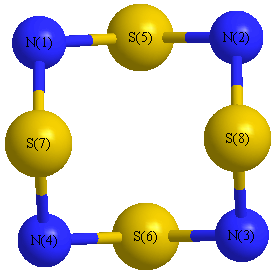Vibrational Frequencies calculated at LSDA/cc-pVTZ
| Mode Number |
Symmetry |
Frequency
(cm-1) |
Scaled Frequency
(cm-1) |
IR Intensities
(km mol-1) |
Raman Act
(Å4/u) |
Dep P |
Dep U |
|---|
| 1 |
A1 |
738 |
730 |
0.00 |
|
|
|
| 2 |
A1 |
570 |
564 |
0.00 |
|
|
|
| 3 |
A1 |
217 |
215 |
0.00 |
|
|
|
| 4 |
A2 |
771 |
763 |
0.00 |
|
|
|
| 5 |
A2 |
258 |
256 |
0.00 |
|
|
|
| 6 |
B1 |
752 |
744 |
0.00 |
|
|
|
| 7 |
B1 |
336 |
332 |
0.00 |
|
|
|
| 8 |
B2 |
974 |
963 |
60.73 |
|
|
|
| 9 |
B2 |
555 |
549 |
58.06 |
|
|
|
| 10 |
B2 |
190 |
188 |
0.27 |
|
|
|
| 11 |
E |
821 |
812 |
2.28 |
|
|
|
| 11 |
E |
821 |
812 |
2.28 |
|
|
|
| 12 |
E |
727 |
719 |
89.47 |
|
|
|
| 12 |
E |
727 |
719 |
89.47 |
|
|
|
| 13 |
E |
515 |
509 |
6.99 |
|
|
|
| 13 |
E |
515 |
509 |
6.99 |
|
|
|
| 14 |
E |
334 |
330 |
15.62 |
|
|
|
| 14 |
E |
334 |
330 |
15.62 |
|
|
|
Unscaled Zero Point Vibrational Energy (zpe) 5076.2 cm
-1
Scaled (by 0.9891) Zero Point Vibrational Energy (zpe) 5020.8 cm
-1
See section
III.C.1 List or set vibrational scaling factors
to change the scale factors used here.
See section
III.C.2
Calculate a vibrational scaling factor for a given set of molecules
to determine the least squares best scaling factor.
Charges, Dipole, Quadrupole and Polarizability
Charges from optimized geometry at LSDA/cc-pVTZ
Charges (e)
| Number |
Element |
Mulliken |
CHELPG |
AIM |
ESP |
| 1 |
N |
-0.352 |
|
|
|
| 2 |
N |
-0.352 |
|
|
|
| 3 |
N |
-0.352 |
|
|
|
| 4 |
N |
-0.352 |
|
|
|
| 5 |
S |
0.352 |
|
|
|
| 6 |
S |
0.352 |
|
|
|
| 7 |
S |
0.352 |
|
|
|
| 8 |
S |
0.352 |
|
|
|
Electric dipole moments
Electric dipole components in Debye
(What's a Debye? See section
VII.A.3)
| |
x |
y |
z |
Total |
| |
0.000 |
0.000 |
0.000 |
0.000 |
| CHELPG |
|
|
|
|
| AIM |
|
|
|
|
| ESP |
|
|
|
|
Electric Quadrupole moment
Quadrupole components in D Å
| Primitive |
|---|
| | x | y | z |
|---|
| x |
-76.372 |
0.000 |
0.000 |
| y |
0.000 |
-76.372 |
0.000 |
| z |
0.000 |
0.000 |
-66.797 |
|
| Traceless |
|---|
| | x | y | z |
|---|
| x |
-4.787 |
0.000 |
0.000 |
| y |
0.000 |
-4.787 |
0.000 |
| z |
0.000 |
0.000 |
9.575 |
|
| Polar |
|---|
| 3z2-r2 | 19.150 |
|---|
| x2-y2 | 0.000 |
|---|
| xy | 0.000 |
|---|
| xz | 0.000 |
|---|
| yz | 0.000 |
|---|
|
Polarizabilities
Components of the polarizability tensor.
Units are
Å
3 (Angstrom cubed)
Change units.
| |
x |
y |
z |
| x |
15.296 |
0.000 |
0.000 |
| y |
0.000 |
15.296 |
0.000 |
| z |
0.000 |
0.000 |
12.068 |
<r2> (average value of r
2) Å
2
| <r2> |
314.065 |
| (<r2>)1/2 |
17.722 |
